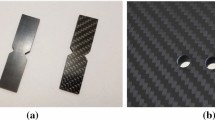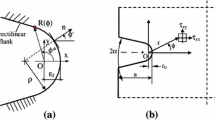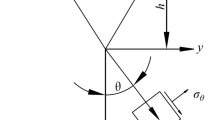Abstract
A bimaterial V-notch composed of two perfectly bonded wedges is considered. For unconstrained notch edges, the eigenvalue problem is solved yielding both real and complex eigenvalues. The appropriate eigenvectors are also determined. A conservative area integral is derived from the Betti reciprocal principle for determination of the stress intensity factors for this geometry. A field more singular than the asymptotic field is employed as an auxiliary solution in the conservative integral. The accuracy of the method is demonstrated by several numerical examples. In addition, results are obtained for a geometry of interest and a wide range of material combinations.
Similar content being viewed by others
References
Akisanya, A.R. and Fleck, N.A. (1997). Interfacial cracking from the free-edge of a long bi-material strip. International Journal of Solids and Structures 34, 1645–1665.
Banks-Sills, L. (1991). Application of the finite element method to linear elastic fracture mechanics”, Applied Mechanics Reviews 44, 447–461.
Banks-Sills, L. and Sherman, D. (1992). On the computation of stress intensity factors for three-dimensional geometries by means of the stiffness derivative and J-integral methods. International Journal of Fracture 53, 1–20.
Banks-Sills, L. (1997). A conservative integral for determining stress intensity factors of a bimaterial strip. International Journal of Fracture 86, 385–398.
Banks-Sills, L. and Sherer, A. (2000). A path-independent integral for computing stress intensity factors of bimaterial V-notches. Tel Aviv University report.
Bathe, K.J. (1997). ADINA - Automatic Dynamic Incremental Nonlinear Analysis, Version 7.3, Adina Engineering Inc., Watertown, Massachusetts.
Carpenter, W.C. (1984a). Calculation of fracture mechanics parameters for a general corner. International Journal of Fracture 24, 45–58.
Carpenter, W.C. (1984b). Mode I and II stress intensities for plates with cracks of finite opening. International Journal of Fracture 26, 201–214.
Carpenter, W.C. (1985). The eigenvector solution for a general corner of finite opening crack with further studies on the collocation procedure. International Journal of Fracture 27, 63–74.
Carpenter, W.C. and Byers, C. (1987). A path independent integral for computing stress intensities for V-notched cracks in a bi-material. International Journal of Fracture 35, 245–268.
Carpenter, W.C. (1995). Insensitivity of the reciprocal work contour integral method to higher order eigenvectors. International Journal of Fracture 73, 93–108.
Comninou, M. and Dundurs, J. (1979). Some consequences of the inequality conditions in contact and crack problems. Journal of Elasticity 9, 71–82.
Dempsey, J.P. and Sinclair, G.B. (1979). On the stress singularities in the plane elasticity of the composite wedge. Journal of Elasticity 9, 373–391.
Dempsey, J.P. and Sinclair, G.B. (1981). On the singular behavior at the vertex of a bi-material wedge. Journal of Elasticity 11, 317–327.
Dempsey, J.P. (1995). Power-logarithmic stress singularities at bi-material corners and interface cracks. Journal of Adhesion Science and Technology 9, 253–265.
Dundurs, J. (1967). Effect of elastic constants on stress in a composite under plane deformation. Journal of Composite Materials 1, 310–322.
Dundurs, J. (1970). Some properties of elastic stresses in a composite. Recent Advances in Engineering Science 5 (Edited by A.C. Eringen), 203–216.
Hein, V.L. and Erdogan, F. (1971) Stress singularities in a two-material wedge. International Journal of Fracture Mechanics 7, 317–330.
Hong, C-C. and Stern, M. (1978). The computation of stress intensity factors in dissimilar materials. Journal of Elasticity 8, 21–34.
Hutchinson, J.W. (1990) Mixed mode fracture mechanics of interfaces. Metal Ceramic Interfaces (Edited by M. Rühle, A.G. Evans, M.F. Ashby and J.P. Hirth), Pergamon Press, Oxford, 295–301.
Irwin, G.R. (1960). Plastic zone near a crack tip and fracture toughness. Seventh Sagamore Ordinance Materials Research Conference 6, 63–79.
Li, F.Z., Shih, C.F. and Needleman, A. (1985). A comparison of methods for calculating energy release rates. Engineering Fracture Mechanics 21, 405–421.
Liu, D. and Fleck, N. (1999). Scale effects in the initiation of cracking of a scarf joint. International Journal of Fracture 95, 67–88.
Liu, X.H., Suo, Z. and Ma, Q. (1999). Split singularities: stress field near the edge of a silicon die on a polymer substrate. Acta Metallurgica 47, 67–76.
MAPLE V (1997). Version 5, Waterloo Maple, Inc., Waterloo.
MATHEMATICA (1999). Version 4.0, Wolfram Research, Inc., Massachusetts.
Munz D. and Yang, Y.Y. (1992). Stress singularities at the interface in bonded dissimilar materials under mechanical and thermal loading. Journal of Applied Mechanics 59, 857–861.
Munz D. and Yang, Y.Y. (1993). Stresses near the edge of bonded dissimilar materials described by two stress intensity factors. International Journal of Fracture 60, 169–177.
Muskhelishvili, N.I. (1953). Some Basic Problems of the Mathematical Theory of Elasticity, Noordhoff, Holland.
Okajima, M and Sinclair, G.B. (1986). A path independent integral for computing singularity participation at a butt joint. In: Proceedings of the International Conference on Computational Mechanics 1, Japan, V-11–V-16.
Pageau, S.S., Gadi, K.S., Biggers, Jr., S.B. and Joseph, P.F. (1996). Standardized complex and logarithmic eigensolutions for n-material wedges and junctions. International Journal of Fracture 77, 51–76.
Rice, J.R. (1988). Elastic fracture mechanics concepts in dissimilar media. Journal of Applied Mechanics 55, 98–103.
Sinclair, G.B., Okajima, M. and Griffin, J.H. (1984). Path independent integrals for computing stress intensity factors at sharp notches in elastic plates. International Journal for Numerical Methods in Engineering 20, 999–1008.
Sinclair, G.B. (1985). A remark on the determination of mode I and mode II stress intensity factors for sharp re-entrant corners. International Journal of Fracture 27, R81–R85.
Stern, M. and Soni, M.L. (1976). On the computation of stress intensities at fixed-free corners. International Journal of Solids and Structures 12, 331–337.
Stern, M., Becker, E.B. and Dunham, R.S. (1976). A contour integral computation of mixed-mode stress intensity factors. International Journal of Fracture 12, 359–368.
Suga, T., Elssner, G. and Schmauder, S. (1988). Composite parameters and mechanical compatibility of material joints. Journal of Composite Materials 22, 917–934.
Theocaris, P.S. (1974). The order of singularity at a multi-wedge corner of a composite plate. International Journal of Engineering Science 12, 107–120.
Ting, T.C.T. (1996). Anisotropic Elasticity-Theory and Applications, Oxford University Press, Oxford, 345.
Yang, Y.Y. (1992). ‘Spannungssingularitäten in Zweistoffverbunden bei mechanischer und thermischer Belastung’, Ph.D. thesis, University of Karlsruhe, Karlsruhe.
Yosibash, Z. and Szabo, B.A. (1995). Generalized stress intensity factors in linear elastostatics. International Journal of Fracture 72, 223–240.
Yosibash, Z. (2000). Personal communication.
Author information
Authors and Affiliations
Rights and permissions
About this article
Cite this article
Banks-Sills, L., Sherer, A. A conservative integral for determining stress intensity factors of a bimaterial notch. International Journal of Fracture 115, 1–25 (2002). https://doi.org/10.1023/A:1015713829569
Issue Date:
DOI: https://doi.org/10.1023/A:1015713829569




